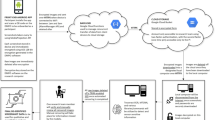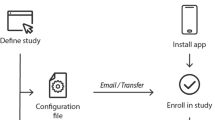Abstract
Objective data on social media use is now urgently needed for understanding its impact on adolescent well-being. Traditional objective social media data collection methods, such as data donation and passive sensing, face challenges including intrusiveness, privacy concerns, and limitations in adolescent—a critical demographic in this research area. In our study, we introduced a novel, less intrusive method using user-donated screenshots within an ecological momentary assessment (EMA) framework. We recruited 374 adolescents from Switzerland, who were instructed to capture and share three daily screenshots detailing their total and app-specific usage across screentime, activations, and notifications. From this, we collected 6,819 screenshots, with 25% of participants failing to submit any screenshots, 14% submitted incorrect or incomplete ones, while 64% provided complete data for more than five days. To process this data, we developed an image-to-text pipeline using Tesseract OCR that achieved a 96% average accuracy rate. This user-donated screenshot method proved to be less burdensome than traditional data donation, capable of capturing detailed app-specific usage across smartphone operating systems, and applicable among adolescents. Nonetheless, success of the user-donated screenshot approach hinges on user compliance. We analyze attrition sources and suggest six strategies to enhance future research, such as incentivizing participation, implementing pre-upload image checks, and improving participant onboarding and education.
Y. Liu, G. Klassen—Co-first author.
Access this chapter
Tax calculation will be finalised at checkout
Purchases are for personal use only
Similar content being viewed by others
References
Massarat, E.A.V.: Risa Gelles-Watnick and Navid: Teens, Social Media and Technology (2022)
NW, 1615 L. St, Washington, S. 800, Inquiries, D. 20036 U.-419-4300 | M.-857-8562 | F.-419-4372 | M.: Social Media Fact Sheet (2024). https://www.pewresearch.org/internet/fact-sheet/social-media/
CDC: Youth Risk Behavior Surveillance Data Summary and Trends Report: 2011–2021 (2021). https://www.cdc.gov/healthyyouth/data/yrbs/pdf/YRBS_Data-Summary-Trends_Report2023_508.pdf
Advisory of U.S. Surgeon General: Social Media and Youth Mental Health — Current Priorities of the U.S. Surgeon General. https://www.hhs.gov/surgeongeneral/priorities/youth-mental-health/social-media/index.html
High, A.C., Ruppel, E.K., McEwan, B., Caughlin, J.P.: Computer-mediated communication and well-being in the age of social media: a systematic review. J. Soc. Pers. Relationsh. 40, 420–458 (2023). https://doi.org/10.1177/02654075221106449
Meier, A., Reinecke, L.: Computer-mediated communication, social media, and men-tal health: a conceptual and empirical meta-review. Commun. Res. 48, 1182–1209 (2021). https://doi.org/10.1177/0093650220958224
Kross, E., Verduyn, P., Sheppes, G., Costello, C.K., Jonides, J., Ybarra, O.: Social media and well-being: pitfalls, progress, and next steps. Trends Cogn. Sci. 25, 55–66 (2021). https://doi.org/10.1016/j.tics.2020.10.005
Orben, A.: Teenagers, screens and social media: a narrative review of reviews and key studies. Soc. Psychiatry Psychiatr. Epidemiol. 55, 407–414 (2020). https://doi.org/10.1007/s00127-019-01825-4
Ohme, J., Araujo, T., de Vreese, C.H., Piotrowski, J.T.: Mobile data donations: as-sessing self-report accuracy and sample biases with the iOS Screen Time function. Mob. Media Commun. 9, 293–313 (2021). https://doi.org/10.1177/2050157920959106
Sultan, M., Scholz, C., van den Bos, W.: Leaving traces behind: using social media digital trace data to study adolescent wellbeing. Comput. Hum. Behav. Rep. 10, 100281 (2023). https://doi.org/10.1016/j.chbr.2023.100281
Ohme, J., et al.: Digital trace data collection for social media effects research: APIs, data dona-tion, and (Screen) tracking. Commun. Methods Meas. 1–18 (2023). https://doi.org/10.1080/19312458.2023.2181319
Davidson, B.I., et al.: Platform-controlled social media APIs threaten Open Science (2023). https://osf.io/ps32z
van Driel, I.I., Giachanou, A., Pouwels, J.L., Boeschoten, L., Beyens, I., Valkenburg, P.M.: Promises and pitfalls of social media data donations. Commun. Methods Meas. 16, 266–282 (2022). https://doi.org/10.1080/19312458.2022.2109608
Stier, S., Breuer, J., Siegers, P., Thorson, K.: Integrating survey data and digital trace data: key issues in developing an emerging field. Soc. Sci. Comput. Rev. 38, 503–516 (2020). https://doi.org/10.1177/0894439319843669
Reeves, B., Robinson, T., Ram, N.: Time for the human screenome project. Nature 577, 314–317 (2020). https://doi.org/10.1038/d41586-020-00032-5
Reeves, B., et al.: Screenomics: a framework to capture and analyze personal life experiences and the ways that technology shapes them. Hum. Comput. Interact. 36, 150–201 (2021). https://doi.org/10.1080/07370024.2019.1578652
Ram, N., Haber, N., Robinson, T.N., Reeves, B.: Binding the person-specific approach to modern AI in the human screenome project: moving past generalizability to transferability. Multivar. Behav. Res. 1–9 (2023). https://doi.org/10.1080/00273171.2023.2229305
Tonkin, S., et al.: Evaluating declines in compliance with ecological momentary assessment in longitu-dinal health behavior research: analyses from a clinical trial. J. Med. Internet Res. 25, e43826 (2023). https://doi.org/10.2196/43826
Acknowledgments
This study was funded by the Swiss National Science Foundation (grant P500PS_202974) and the NIH/NIMH (grant 1R21HD115354-01).
Author information
Authors and Affiliations
Corresponding author
Editor information
Editors and Affiliations
Rights and permissions
Copyright information
© 2024 The Author(s), under exclusive license to Springer Nature Switzerland AG
About this paper
Cite this paper
Liu, Y. et al. (2024). User-Donated Screenshots Analysis: Feasibility of a New Approach to Collect Objective Social Media App Usage in Adolescents. In: Thomson, R., et al. Social, Cultural, and Behavioral Modeling. SBP-BRiMS 2024. Lecture Notes in Computer Science, vol 14972. Springer, Cham. https://doi.org/10.1007/978-3-031-72241-7_8
Download citation
DOI: https://doi.org/10.1007/978-3-031-72241-7_8
Published:
Publisher Name: Springer, Cham
Print ISBN: 978-3-031-72240-0
Online ISBN: 978-3-031-72241-7
eBook Packages: Computer ScienceComputer Science (R0)




